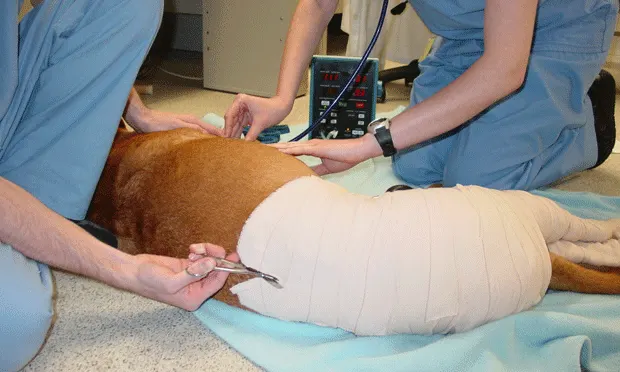Placement of an Abdominal Wrap to Control Hemodynamics
Louisa Rahilly, DVM, Diplomate ACVECC, Cape Cod Veterinary Specialists, Buzzards Bay, Massachusetts
Lori S. Waddell, DVM, DACVECC, University of Pennsylvania

Application of pressure to the abdomen via an abdominal wrap is a management technique often used in veterinary medicine to improve blood pressure and slow or arrest bleeding in patients suffering from abdominal hemorrhage and hemodynamic instability.1 Abdominal wraps incorporating the pelvic limbs, pelvis, and abdomen can also be used to immobilize and slow hemorrhage associated with femoral or pelvic fractures.
Hemoabdomen & Shock
Intraabdominal hemorrhage can occur in companion animals due to trauma, neoplasia, coagulopathies, liver lobe torsion, or splenic volvulus.2 In cats, most cases of spontaneous hemoabdomen are attributable to hepatic neoplasia or pathology, whereas dogs typically suffer from splenic disease.2,3 Animals presenting with hemoabdomen are often in hypovolemic shock.
In early stages of hemorrhagic shock, dogs are often still compensating with tachycardia, pale mucous membranes, and normal or even elevated blood pressure. As the shock persists, or if it is initially severe, the animal may progress to decompensatory shock and develop hypotension as well as indices of poor perfusion, such as cold extremities, depressed mentation, and elevated lactate levels. Stabilization of these animals requires replacement of volume with crystalloids, colloids, and potentially blood products.
Indications & Complications
In general, abdominal hemorrhage secondary to neoplasia is less likely to ultimately resolve without surgical intervention, while traumatic or coagulopathic causes of hemoabdomen frequently resolve with medical management alone. Any cause of bleeding, however, may be slowed or even stopped by an abdominal wrap and the counterpressure may provide stabilization while preparing for surgery.
Although the incidence of adverse events is relatively low, abdominal wraps have been associated with complications in humans due to decreased perfusion to abdominal organs and pressure necrosis of skin and muscle beds under the pressure garment.4,5 Therefore, we consider using abdominal counterpressure in veterinary patients suffering from abdominal, pelvic, or femoral hemorrhage that do not initially stabilize with adequate fluid administration or are in decompensatory shock at presentation.
Related Article: Blood Transfusion Basics
Related Article: Treatment of Acute Hemoabdomen in a Dog
How the Wrap Works
Theoretically, abdominal counterpressure can both decrease hemorrhage and increase systemic blood pressure. According to Poiseuille’s Law, flow within the vessels is directly proportional to the radius raised to the 4th power as well as the pressure gradient across the vessel wall.6 A small decrease in radius will have a significant effect on flow within the vessel and may reduce hemorrhage.
Counterpressure, either within or outside the abdomen, will decrease the pressure gradient across the wall of all the vessels it affects, additionally decreasing flow. Furthermore, the reduction in vessel diameter that has been demonstrated with the application of abdominal counterpressure causes an overall increase in systemic vascular resistance and ultimately an increase in mean arterial pressure.6
Numerous experimental studies in dogs and retrospective analysis of pressure garments or wraps in people have been performed with conflicting effects on cardiac output.2,6-8 However, these studies have demonstrated fairly consistent increases in systemic vascular resistance and blood pressure. Abdominal wraps have been shown to decrease tidal volume, cause tachypnea, and compromise ventilation; therefore this intervention is contraindicated in cases with respiratory compromise, such as pulmonary contusions, pleural space disease, or diaphragmatic hernia.
Step by Step: How to Place an Abdominal Wrap
What You Will Need
Cast padding, rolled cotton, or towels
Adhesive bandage material
Bandage scissors or a scalpel blade

STEP 1
Correct application of abdominal counterpressure requires wrapping the hindlimbs from the toes up, including the pelvis and the abdomen, with elastic bandages, Vetrap (3M.com/animalcare), Elastikon (jnj.com), or duct tape. An initial layer of cast padding, rolled cotton, or towels is recommended to more evenly distribute pressure and to facilitate removal of adhesive materials.
Place the initial layer of cotton by wrapping the hindlegs in a “barber pole” fashion. Including the hindquarters in the wrap is important as application of an abdominal wrap alone results in decreased venous return and a potentially detrimental reduction in cardiac output.
Procedure Pearl
An initial layer of cast padding, rolled cotton, or towels is recommended to more evenly distribute pressure and to facilitate removal of adhesive materials.
Monitoring
Diligent monitoring of the respiratory system while placing an abdominal wrap is necessary as abdominal counterpressure may exacerbate previously undiagnosed respiratory pathology and may bring about respiratory decompensation. This is particularly true in cases of diaphragmatic hernia as abdominal organs are pushed into the thoracic cavity.
Clinicians should also be aware of systemic effects of the wrap because abdominal counterpressure causes increased intraabdominal pressure. Intraabdominal hypertension of greater than approximately 25 cm H2O can result in compromise of the renal, cardiovascular, visceral, hormonal, pulmonary, and neurologic systems. Decreased glomerular filtration rate, urine production, venous return, pulmonary compliance, and splanchnic perfusion, as well as increased risk of bacterial translocation have been documented in both human patients and experimental scenarios of intraabdominal hypertension.
Additionally, catecholamine, antidiuretic hormone, renin, and aldosterone release have been shown to be increased. Therefore, abdominal wraps should be used with caution and left in place only as long as necessary to achieve acceptable indices of perfusion, control of hemorrhage, and cardiovascular stability. We recommend leaving the wrap in place for no longer than 12 hours. If cardiovascular stability has not been achieved with the use of abdominal counterpressure and adequate fluid and blood product resuscitation by this time, one should consider surgical exploration to control bleeding.